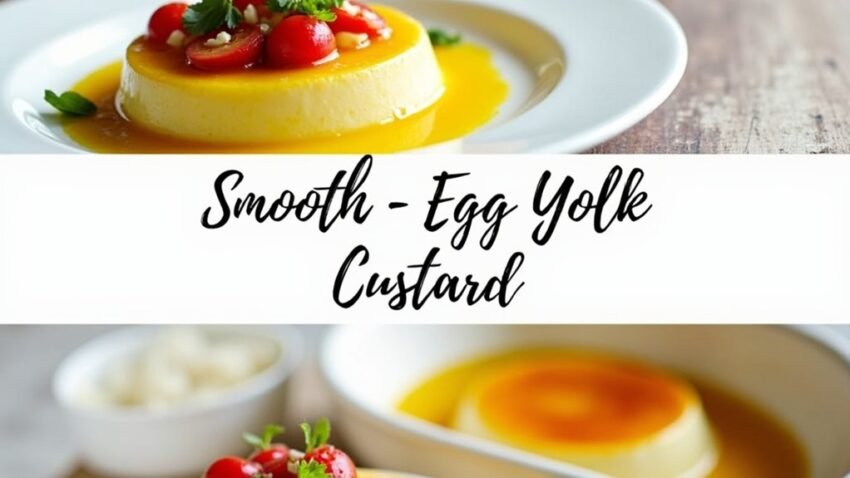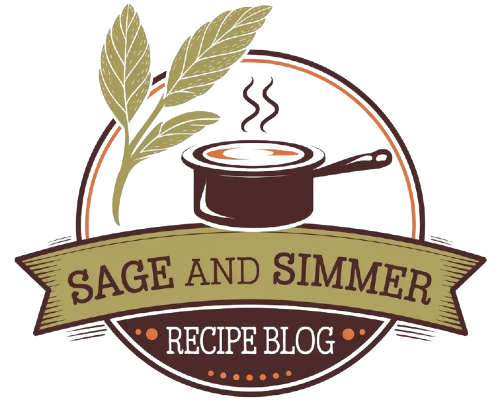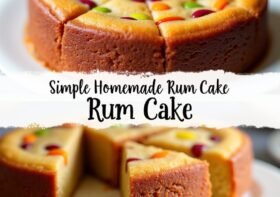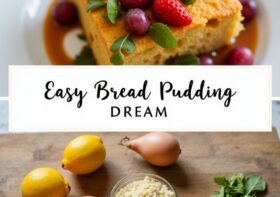Smooth Egg Yolk Custard Recipe

Smooth Egg Yolk Custard Recipe
If you’re looking to create a dessert that embodies both simplicity and elegance, the smooth egg yolk custard might just be the answer. You’ll find that this recipe balances rich flavors with a silky texture, making it a versatile choice for various occasions. By mastering the technique of tempering egg yolks and controlling the heat, you can achieve a custard that’s not only delicious but also visually appealing. Yet, there’s more to this custard than meets the eye, especially when you consider its history and potential variations.
Key Takeaways
- Whisk together egg yolks, sugar, and cornstarch in a bowl to create a smooth base for the custard.
- Heat milk and cream gently in a saucepan until simmering, then gradually whisk into the egg mixture to temper.
- Return the mixture to the saucepan and cook over medium-low heat, whisking constantly to achieve a creamy texture.
- Strain the custard through a fine mesh sieve to eliminate lumps and ensure a silky finish.
- Chill the custard for at least 2 hours before serving for optimal flavor and texture.
History
Custard has a rich history that dates back to ancient Rome, evolving into a staple of European cuisine by the Middle Ages. The term “custard” originates from the French word “croustade,” which refers to a pastry crust commonly used in custard dishes.
Key points about custard’s history include:
-
Early Development: By the 17th century, set custards gained popularity, thanks to advancements in oven technology.
-
Global Influence: While custards were mainly enjoyed in Europe, they also found a place in Asian culinary traditions during the Middle Ages.
-
Versatile Uses: Custards served both savory and sweet purposes, often paired with pastries to create delightful tarts. Traditional serving methods included jelly glasses and custard stands, showcasing the cultural significance of custards.
In England, egg custards became particularly popular, taking the form of loose sauces and set desserts baked in tart shells.
The influence of French culinary techniques led to a shift towards egg yolk custards in America, as seen in early cookbooks like Mary Lincoln’s 1884 publication. This change caused a decline in traditional whole egg custard recipes.
Recipe
Creating a smooth and creamy egg yolk custard is a delightful process that results in a rich dessert perfect for any occasion. This custard can be enjoyed on its own, served with fresh fruits, or used as a filling for pastries. The key to achieving the perfect texture lies in the careful tempering of the egg yolks and the slow cooking process which prevents curdling and guarantees a velvety finish.
To get started, gather all your ingredients and equipment. Using a double boiler or a heavy-bottomed saucepan will help regulate the heat and prevent the custard from burning. Keep in mind to whisk continuously while combining the ingredients to achieve a smooth consistency. Patience is essential, as the custard may take some time to thicken, but the end result will be well worth the effort. Chilling allows custard to set for a velvety texture; minimum chilling time is 2 hours in the refrigerator.
Ingredients:
– 6 large egg yolks
– 2 cups whole milk or fresh raw cream
– 3/4 cup (150g) sugar, 1/3 cup maple syrup, or 1/4 cup white sugar
– 1/4 cup (28g) cornstarch
– 1 tsp vanilla extract
– Additional butter or flavorings, if desired
Instructions:
In a medium bowl, whisk together the egg yolks, sugar, and cornstarch until well combined.
In a saucepan, combine the milk and heavy cream and bring to a gentle simmer over medium heat, adding the vanilla extract as it warms.
Gradually whisk the hot milk mixture into the egg yolks, a little at a time, to temper them and avoid scrambling.
Once fully combined, return the mixture to the saucepan and cook over medium-low heat, whisking continuously until the custard thickens enough to coat the back of a spoon.
Be vigilant to scrape the corners and bottom of the pan to prevent lumps.
Once done, remove from heat and add any additional butter or flavorings if desired.
Extra Tips:
For the best results, make sure that your ingredients are at room temperature before starting, as this will help them combine more easily and evenly.
If you find that your custard has thickened too much or has formed lumps, you can strain it through a fine mesh sieve to achieve a smoother texture.
Additionally, keep in mind that the custard will continue to thicken slightly as it cools, so avoid overcooking.
Enjoy your smooth egg yolk custard served warm or chilled!
Final Thoughts
Achieving a perfect smooth egg yolk custard requires attention to detail, but the rewards are definitely worth it. This creamy dessert can raise any meal, and mastering it will impress your family and friends. Here are a few key considerations to keep in mind.
-
Tempering: Always temper your egg yolks with hot milk to avoid scrambling. Slowly whisk the hot milk into the yolks for best results.
-
Cooking Temperature: Aim for a cooking temperature of 185 F-190 F. This guarantees proper thickening and kills unwanted enzymes. Remember that achieving this cooked mixture is essential for the custard to set properly.
-
Stirring: Stir constantly over low heat to maintain smoothness and prevent lumps.
-
Cooling: Cool the custard quickly while stirring to help it set perfectly.
Avoid common pitfalls such as insufficient heating, overmixing, or overcooking. Using whole milk can improve creaminess, and adding flavorings like vanilla can uplift your custard’s taste.
Finally, don’t forget to strain the mixture before serving; this step guarantees a silky texture without any lumps. With these tips, you’ll create a custard that’s not just smooth but also delightful. Enjoy your culinary success!
FAQ
Here are some frequently asked questions about smooth egg yolk custard that can help you troubleshoot common issues and improve your technique.
How can I prevent my custard from curdling?
-
Temper the egg yolks by gradually adding hot milk to avoid quick cooking.
-
Cook on low heat**** to reduce the risk of curdling.
-
Stir constantly to guarantee even heat distribution.
What should I do if my custard starts to curdle?
-
Act quickly by cooling it; dip the pan in a cold water bath.
-
Strain the mixture through a fine mesh strainer for a smoother texture.
-
Use a hand blender to pulse larger grains before straining.
What common mistakes should I avoid?
-
Don’t overheat the custard; high temperatures lead to curdling.
-
Avoid insufficient tempering by adding hot milk too quickly.
-
Don’t skip stirring, as it can cause uneven cooking.
What if my custard is still grainy after attempts to fix it?
- If it’s still unsatisfactory, consider discarding it or trying no-churn ice cream recipes as an alternative. Additionally, remember that even if the custard has curdled, it can still be used as a base for ice cream if the texture is improved through straining.



